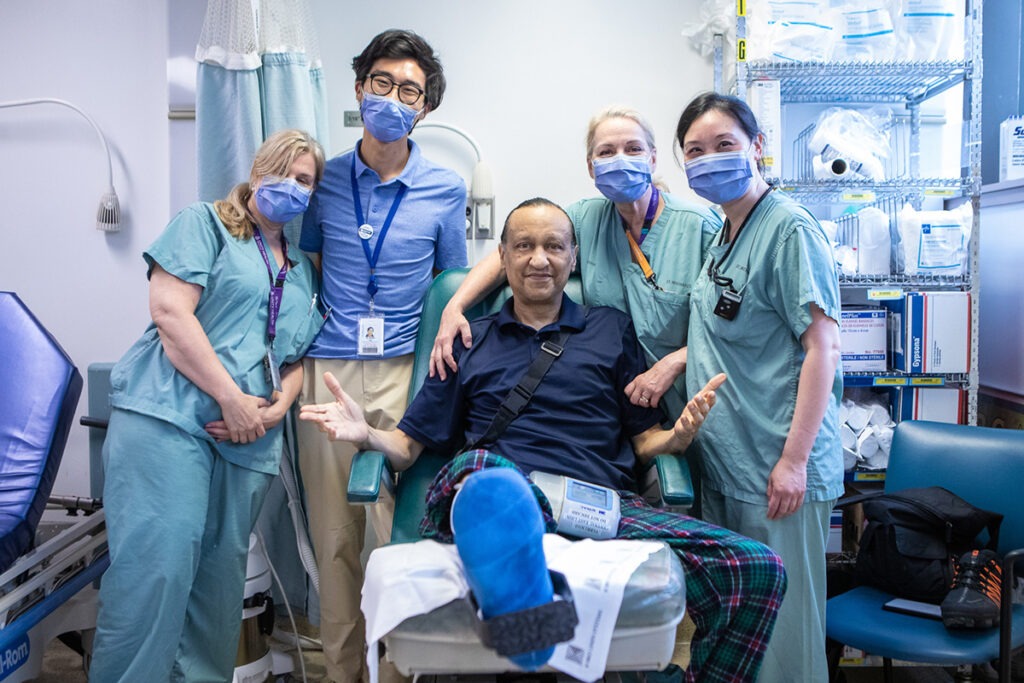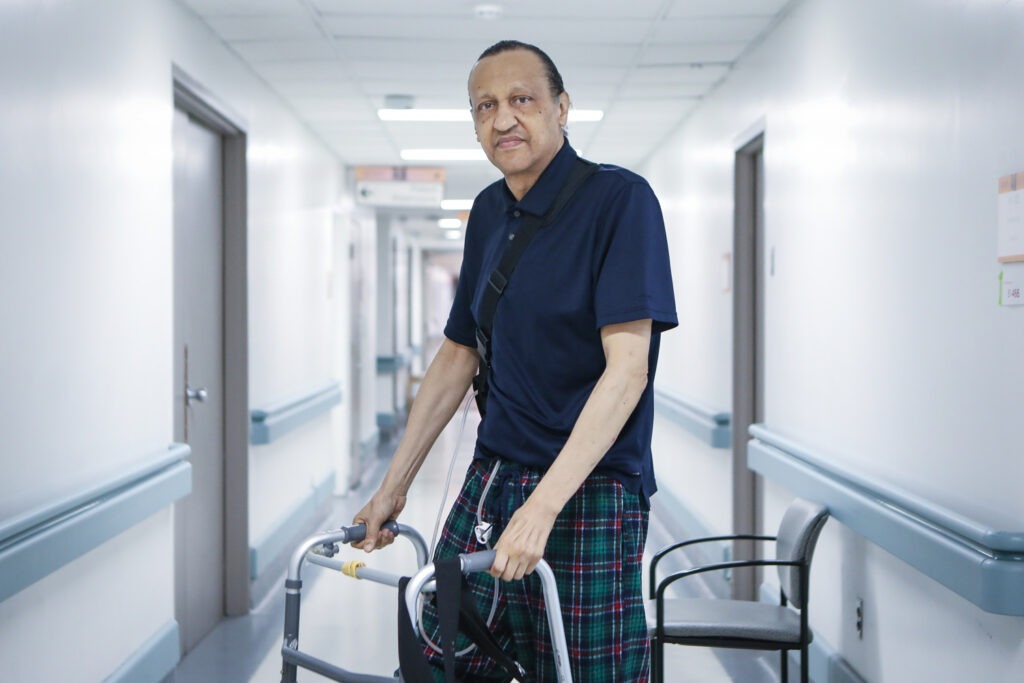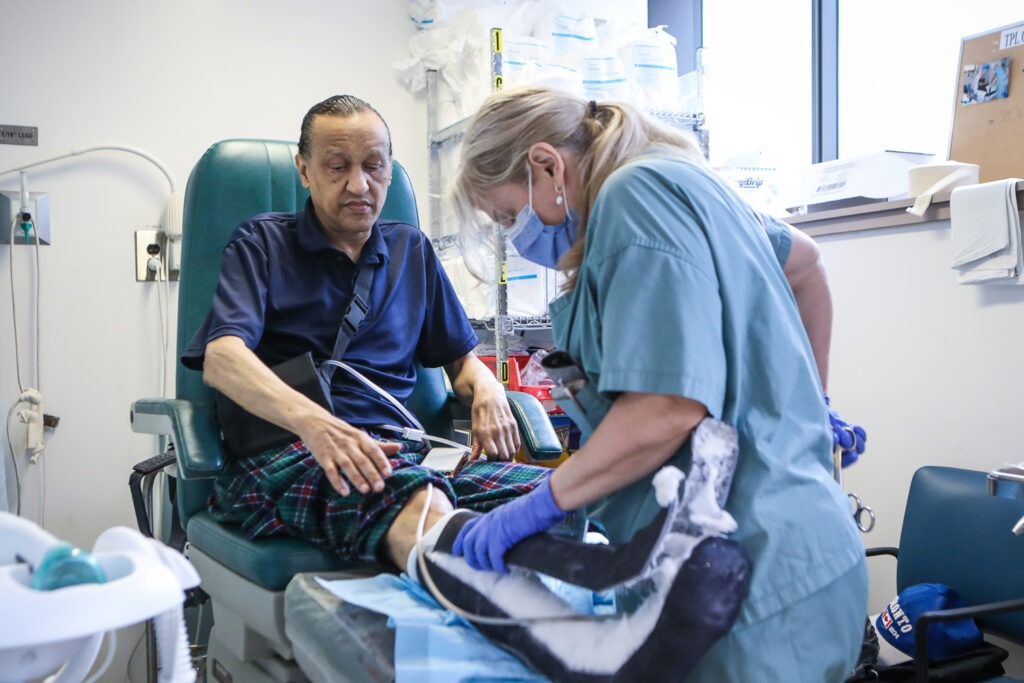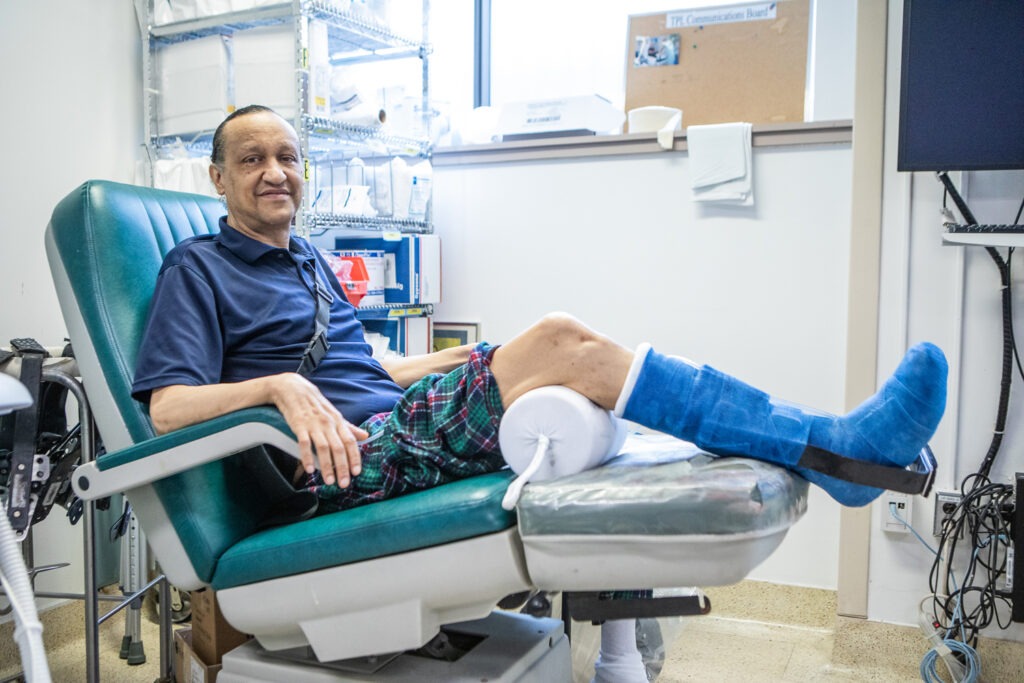Add chiropodists and what do you get? A unique St. Michael’s program improving care for patients with serious foot wounds

Mark Saldeba’s outpatient diabetic foot pathway care team. Catherine Škrabec, Orthopedic Technologist; Dr. Charlie Tan, Staff Physician, Infectious Disease; Mark Saldeba, patient; Ann-Marie McLaren and Suzanne Lu, Wound Chiropodists/Foot and Ankle Clinical Coordinators
Mark Saldeba has been stuck in a cast for two months to treat a foot ulcer, but you won’t catch him complaining. He considers himself lucky because unlike too many others with diabetes who have the same condition and eventually require amputation, his foot is on the mend.
Had he not been treated at St. Michael’s Hospital, Saldeba says, “I definitely would have had a different outcome.”
What’s different about treatment at St. Michael’s is that when a patient comes to the emergency department (ED) with a diabetic foot ulcer and requires hospitalization, they are seen by a dedicated multidisciplinary team, co-led by chiropodists, who determine what next steps are needed. St. Michael’s, a site of Unity Health Toronto, is the only hospital in Canada that involves wound chiropodists to help execute this novel diabetic foot ulcer pathway, according to the team. General internal medicine and vascular surgery are also part of the core team, with support from other specialties as necessary.
A quality improvement study published in the International Wound Journal that analyzed the multidisciplinary team’s work found that the pathway helped to cut hospital stays in half, from about 16 days to eight, and reduced hospitalization costs by about $2,000 per patient. It also likely led to decreased amputation rates, which Dr. Charles de Mestral, a vascular surgeon who is the study’s senior author, says the team will evaluate in future work.
Diabetic foot ulcers can start from something as simple as a small cut. But due to nerve damage and poor circulation, common issues for people with diabetes, that cut can grow into a large open wound. And if left untreated, leg amputation could be required. Up to 25 per cent of Canadians with diabetes will experience a diabetic foot ulcer in their lifetime and of that, 20 per cent will lose a limb. Every day, 16 Canadians lose a leg to diabetes.
In most Canadian hospitals, when these patients come to the ED, who gets called to help is very variable. And that has an impact on outcomes. “Patients do better when there is a standardized team-based approach to workup and treatment. We’ve standardized assessment and streamlined care,” says de Mestral of the pathway.
While the core team includes vascular surgery and general internal medicine, de Mestral emphasizes the work of one discipline: the wound chiropodists. “Chiropody is the linchpin to the team because of their unique expertise and focus on diabetic foot ulcer healing,” he says.
Chiropodists are regulated health professionals who assess, treat and manage conditions of the foot. And unlike any other discipline in the hospital, the foot is their sole focus, making them best suited to lead the diabetic foot ulcer team.
St. Michael’s has three wound chiropodists—Ann-Marie McLaren, Suzanne Lu and Sreenath Rave—a benefit that many hospitals don’t have as most chiropodists work in private clinics, say McLaren and Lu.
“It doesn’t matter what country you’re looking at, there’s a lack of chiropody being involved in the hospital system,” says McLaren. “This project really shows how this pathway can mitigate and change the outcome for patients, and it also shows how important we are to be part of the team.”
McLaren and Lu have been leaders in creating and implementing the novel acute care pathway at St. Michael’s, but their work hasn’t stopped there. They also play a key role in supporting patients as they transition to outpatient care and beyond.
“Luckily, I met two friends: Suzanne and Ann-Marie,” says Saldeba. “They were the first ones on the scene to take a look. Right away they made me feel at home.”
From there, Saldeba says McLaren and Lu have provided him with education about the importance of blood sugar management and its impact on wound healing, avoiding pressure on the ulcer with a specialized cast, use of advanced wound therapies, and how to check his feet. All of which, he says, will help prevent him from getting another ulcer in the future. He also says their ongoing support and attentiveness have made him really feel cared for, which has helped with mental healing.
“Their value: I can’t put words around it,” he says of the chiropodists.
Ontario Health recently developed Ontario’s Lower-Limb Preservation Strategy which aims to reduce lower limb amputations, de Mestral says. St. Michael’s is participating as one of six pilot sites for implementation of the strategy provincially. The team is looking forward to integrating with community-based prevention efforts within the Downtown East Toronto Ontario Health Team.
By Kaitlin Jingco; Photos by Eduardo Lima






